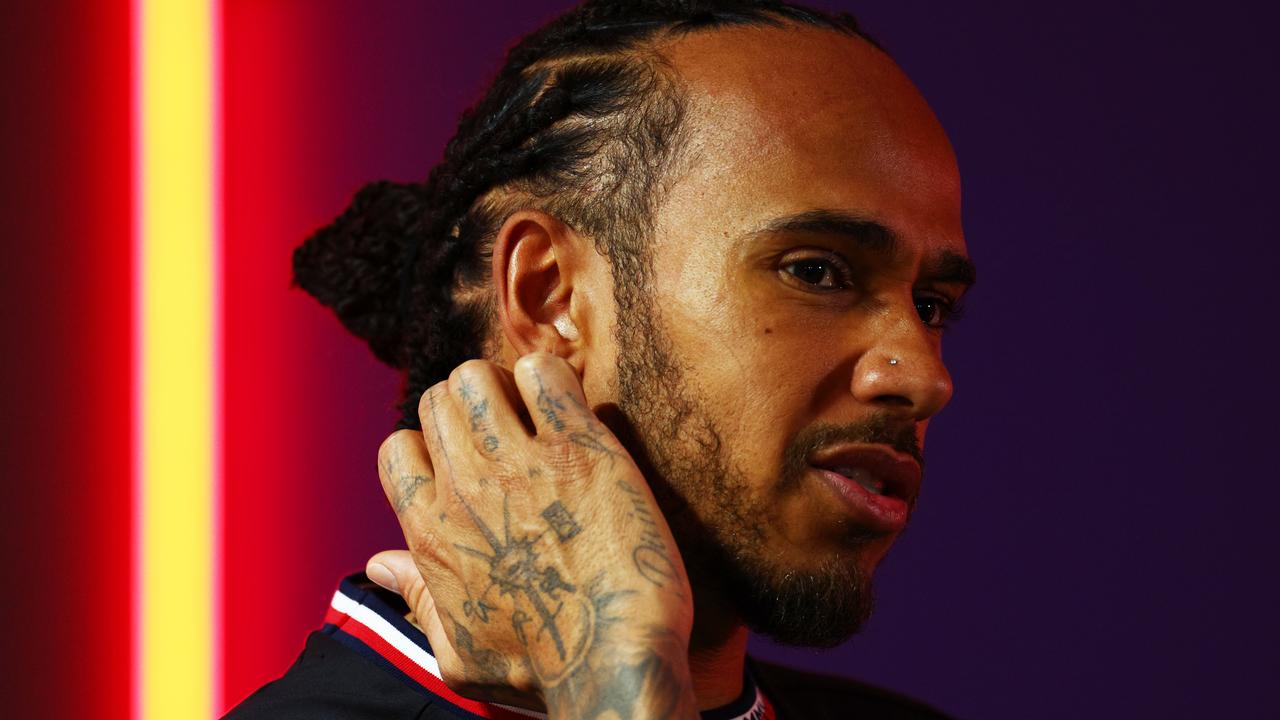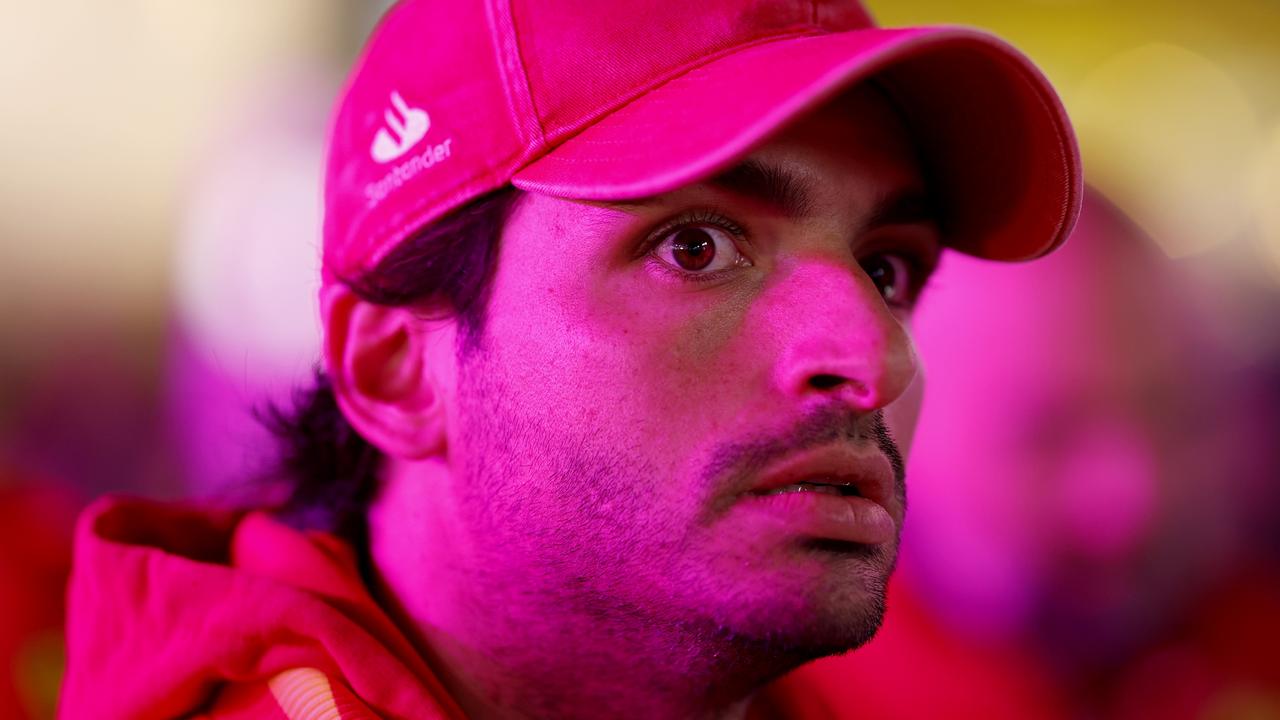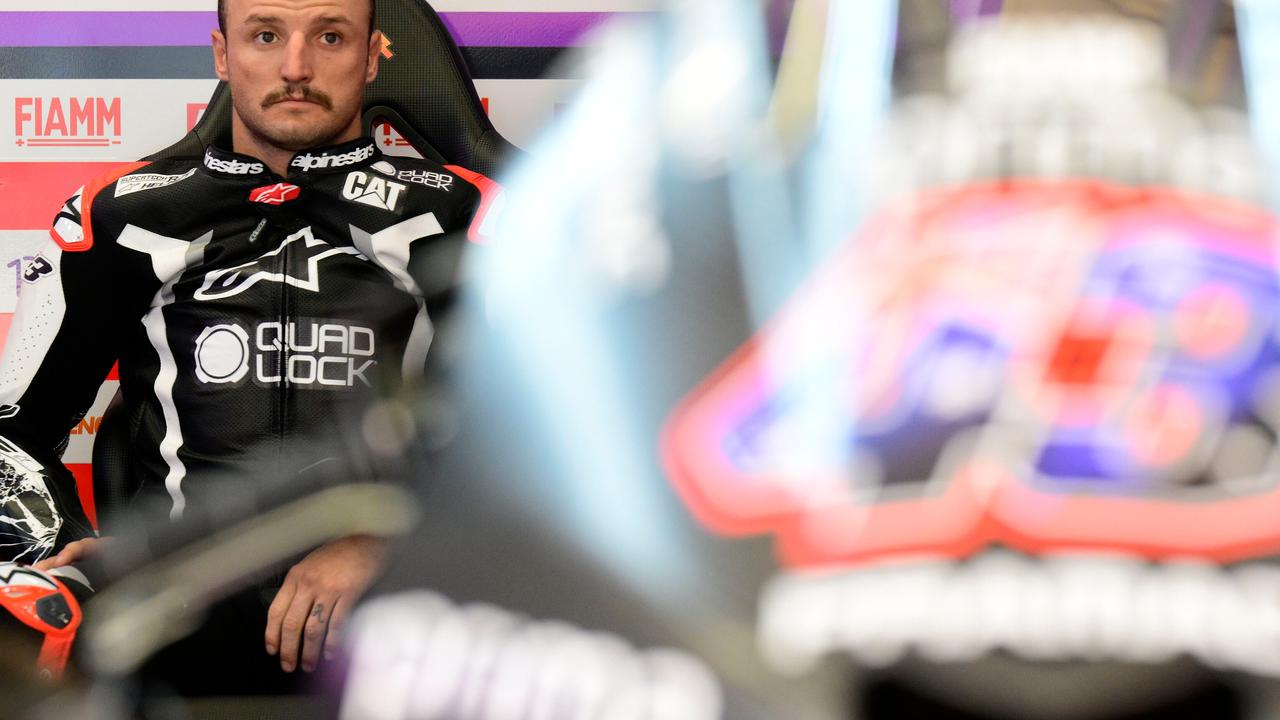An F1 legend may be past his ‘shelf life’. His next move could be the antidote… or end in disaster

There has been no greater relationship in Formula 1 than the partnership between Mercedes and Lewis Hamilton. This prolific team-driver combination has conquered every frontier in Formula 1.
F1 LAS VEGAS SUNDAY 5PM AEDT | Who will cash in, in Sin City? Watch every lap LIVE in 4K on Kayo. New to Kayo? Get your first month for just $1. Limited time offer.
No driver in the sport’s history has spent so long with one team, with Hamilton clocking up 243 grands prix with the Silver Arrows — and that’s set to rise to 246 by the end of the season.
That’ll be 60 more than Max Verstappen’s 186 with Red Bull Racing and 66 more than Michael Schumacher’s 180 with Ferrari.
Hamilton’s six championships with Mercedes are unprecedented; Schumacher’s five with Ferrari is next best.
His 84 grand prix victories in silver are 12 more than Schumacher’s 72 in red.
The most successful pole-getter of all time has 78 P1 starts with Mercedes, 20 more than Schumacher’s 58 with Ferrari.
Some of these stats might individually one day be broken, but the odds of one driver taking the set is seriously unlikely.
Hamilton and Mercedes stand alone at the pinnacle of Formula 1.
But all good things must come to an end.
These are the last three weeks of a partnership that have defined an era of grand prix racing.
But with both team and driver in insipid form, the relationship won’t be ending on a high.
“I’m not fighting for the championship,” Hamilton lamented, per Autosport. “Doesn’t matter, really, where we finish in the championship.
“I just want to keep the car out the wall and try to score points if I can for the team — if I can finish.
“If they give me a car that doesn’t bounce off the track in the next few races, then hopefully we can get a better result.
“But yeah, looking forward to Christmas.”
Rather than going out in a blaze of glory, this once unbreakable partnership will fade quietly into the Abu Dhabi night, two greats of the sport parting ways mired in unbecoming mediocrity.
PIT TALK PODCAST: F1’s follow-up visit to its premier Las Vegas Grand Prix comes with title permutations, with Max Verstappen on the brink of sealing a fourth championship, while Ferrari is targeting big gains on McLaren at the top of the teams standings.
‘EVERYONE HAS A SHELF LIFE’
If you’re Mercedes boss Toto Wolff, you’d be tempted to see Hamilton’s decision to quit the team as a gift.
The weight of expectation that comes with fielding one of the greatest drivers of all time is significant, and the pressure to deliver with the Briton’s competitive biological clock ticking must be becoming unbearable.
Hamilton will be 40 years old in January and will be racing long beyond when he would have originally envisaged retiring during his title-winning pomp.
He’s all but explicitly tied his longevity to the pursuit of his lost eighth world championship, which he came within a lap and a bungled call from race control of winning in 2021.
With Mercedes’s continued underperformance, with the rise of George Russell and with the sport more competitive than ever, it’s an objective that’s never looked further from being met.
“I like the situation,” Wolff is quoted as saying in new book Inside Mercedes. “It helps us because it avoids the moment where we need to tell the sport’s most iconic driver that we want to stop.”
Wolff went further than simply linking Hamilton’s departure to a simple pressure release, however.
“There’s a reason why we only signed a one-plus-one-year contract,” he said of the deal that allowed Hamilton to break ranks suddenly during the off-season.
“We’re in a sport where cognitive sharpness is extremely important, and I believe everyone has a shelf life.
“It’s the same in football. Managers like Sir Alex Ferguson or Pep Guardiola, they anticipated it in the performance of their top stars and brought in junior players who drove the team for the next years.
“I absolutely had it on my radar that Lewis would go.”
While Wolff isn’t saying that Hamilton has lost his edge, he is saying that he thinks he could be past his usefulness to the team in the next 12 months, requiring the seven-time champion to be kept on a short contractual leash.
It’s a remarkable admission about the greatest driver of his generation.
But there’s also no doubt Hamilton’s last season with Mercedes has almost exclusively underwhelmed.
RUSSELL’S RISE CASTS SHADOW OVER HAMILTON’S LAST MERCEDES SEASON
Hamilton has a history of dominating his teammates, having been beaten only three times by a driver in identical machinery.
Jenson Button was the first in 2011, a difficult but formative year off-track for Hamilton.
Nico Rosberg was the second in their fraught 2016 championship campaign.
George Russell was the third in 2022, when Hamilton shouldered the burden of troubleshooting Mercedes’s first miserable ground-effects car.
Hamilton comfortably beat Russell last season, but in 2024, their third and final campaign together, momentum has swung meritoriously in favour of the younger man.
It’s a comparison that’s done nothing to dispel the perception that Hamilton could be past his prime.
Comparing their vital statistics paints a fascinating picture.
Mercedes teammates compared, 2024
Qualifying head to head: Russell ahead 16-5
Time differential: Russell faster by 0.180 seconds
Grid differential: Russell ahead by 2.71 places
Race head to head: Russell ahead 11-6
Finish differential position: Russell ahead by 1.12 places
Points: Russell ahead 192-190
On every metric Russell is ahead. In qualifying the margin is decisive — no mean feat against the most prolific pole-getter in Formula 1 history.
But Hamilton has high-level defenders inside Mercedes, who say his unusually lacklustre intrateam record isn’t down to an intrinsic loss of form but rather a fundamental mismatch with this generation of car.
“Lewis has not by accident been the best qualifier in the history of the sport — I think he’s been the best driver in the sport — but he’s struggling to make it stick this year by fine margins,” Mercedes technical director James Allison told the Beyond the Grid podcast in June after Russell had taken an 8-1 qualifying lead.
“I think to a degree that the current car-tyre combo — not just us, across the pit lane — doesn’t like being hustled.
“You almost get the best lap times when you’re not trying,
“Every weekend in some session or other you’ll see some car and think, ‘How did that get there?’. And then they don’t do it again; it disappears in the mist straight after.
“I think in qualifying it’s quite hard — when you’re all pumped up and wanting to get the best from it — to do a lap that is relaxed enough to get the best out of the car.
“I think it’s much more even in the race, and Lewis’s race pace has been very strong relative to George on a number of occasions this year, but in qualifying George has definitely had the better of it.”
Trackside engineering director Andrew Shovlin said there were also characteristics specific to Mercedes’s car, beyond the regulations, that weren’t working with Hamilton’s preferred approach to putting together a lap.
“It’s more just the way that he wants to attack a corner,” he said. “When you do that, then the car would snap to oversteer and you start to build tyre temperature.
“Most of our work has been trying to give him a car that you can drive the very attacking style, extract the lap time out of it without it just sort of breaking away on the way in and catching him by surprise.”
Russell, on the other hand, has proved less sensitive. Some of that is down to the phenomenon whereby a driver steps up from an inferior car — in Russell’s case Williams — and simply feels the limitations less as they revel in the greater potential. But some of it is undoubtedly, and somewhat surprisingly, a greater adaptability.
But the combination of this set of rules and Mercedes’s inability to master them has proved lethal to Hamilton’s ordinarily class-leading qualifying form.
Worse, though, is that it’s started to bleed into his Sunday form too.
IT’S GOT WORSE SINCE THE MIDSEASON BREAK
Though Hamilton and Russell are closely matched on points, the tally tells a misleading story in attempting to analyse Hamilton’s struggles.
Instead it’s useful to divide the season into halves.
Mercedes 2024 points comparison
Score before the mid-season break: Hamilton ahead 150-116
Score after the mid-season break: Russell ahead 76-40
It’s worth noting that Hamilton would have been ahead by just two points, 143-141, in the first half of the season had Russell not been disqualified from the Belgian Grand Prix.
It’s remarkable how clearly delineated Hamilton’s pre-break and post-break performances are, having won two of the four races before the adjournment but having managed a best result of fourth ever since.
Some of it is also circumstantial. After inheriting victory in Austria, Mercedes performed strongly on the smooth, high-speed tracks of Silverstone and Spa-Francorchamps in cool ambient conditions, a combination of factors that have played to its car all season.
But more important is that his downturn correlates directly with Mercedes attempting to take subsequent steps with the car developments that briefly turned the W15 into a true frontrunner.
The team insists the new parts have added the expected downforce loads and should therefore boost performance.
But the team has also hinted that it’s come at the expense of driveability, narrowing the set-up window and hindering Hamilton from configuring the car the way he likes it.
“A lot of the pace of the cars in this year particularly is down to how well they handle,” Allison said after the Dutch Grand Prix, the first race at which the team used its next-generation floor.
“It’s not just a question of ‘does your aero package deliver you downforce?’ but, ‘Is it delivering you the balanced car that you need through the corners? Is it delivering you the balanced car you need from high speed to low speed?’.
“We’re not certain that it delivered good balance — something we need to investigate as we go on through the year.”
The car’s usability appeared to be narrowed again by a further upgrade brought to the United States Grand Prix.
Hamilton spoke approvingly of the new parts after sprint qualifying, when he was a contender for pole before yellow flags scuppered his final flying lap.
But he then blamed the new parts for him uncharacteristically spinning himself out of the race on Sunday.
It’s possible for both things to be true — the Mercedes car is just that peaky with its minuscule operating window.
Sao Paulo, though, was the nadir.
It was a sprint weekend, which meant just one hour of practice to hone set-up, and the newly resurfaced Interlagos track was almost undrivable for its bumpiness.
It was hot for sprint qualifying and the sprint race — unfavourable for Mercedes — then the heavens opened for qualifying and the grand prix.
If there’s one thing you don’t want in the wet, it’s a snappy, unpredictable car.
It was the worst of all worlds, and for Hamilton it meant elimination in Q1 for the second time in three races and failure to make Q3 for the third time in seven rounds.
He was scoreless in the sprint and took home a single point on Sunday behind Liam Lawson and ahead of Sergio Pérez.
On all counts he was a long way behind Russell, who’s consistently been happier to deal with what even he describes as a chronically indecisive car.
“Qualifying was bad. Sprint race was bad. The car’s just been bad all weekend,” Hamilton said.
“Obviously it’s devastating to have these bad races in the second half of the season, but all I can say is we’re trying.
“It’s definitely not acceptable. It’s definitely not good enough, and we have to take accountability. I have to take accountability, but I am doing the best with what I’ve got.
“The car has been the worst this weekend and I don’t know what it is. We’re going to have to find out what it is.”
FERRARI COULD BE THE ANTIDOTE
But there’s a second element undoubtedly at play too.
Hamilton looks a lot like a driver who’s put his head down — like a driver hoping to just get the season finished and make it to Christmas.
It’s understandable that a driver with his record would be unenthused by the prospect of battling with his teammate to decide who finishes sixth and seventh on the title table, while Mercedes can’t finish higher or lower than fourth in the constructors championship.
And with his Ferrari move looming on the horizon, there’s little joy to draw from working on experimental parts and set-ups for 2025 in his final silver days.
But it also speaks to the reason Hamilton is leaving in the first place — the counterargument to talk that he’s over the hill.
After what will be an unprecedented 246 races to go with his six championships, 84 race wins and 78 poles with Mercedes, there’s nothing left for him to prove in committing to a long-term Brackley rebuild. He’s been there and done that. It’s unexciting.
Moving to Ferrari, though, isn’t just about the chance to roll the dice on more success; it’s about rediscovering his zeal to squeeze the last percentage points of competitiveness from himself.
‘The time is right to make a change and take on a new challenge,” he said after making his shock announcement at the start of the year.
“I still remember the feeling of taking a leap of faith into the unknown when I first joined Mercedes in 2013. I know some people didn’t understand it at the time, but I was right to make the move then, and it’s the feeling I have again now.
“I’m excited to see what I can bring to this new opportunity and what we can do together.”
At Ferrari he’ll be racing for a team that wants him enough to offer him a long-term contract, not the short faithless leash of one-plus-one-year deal.
Team principal Frédéric Vasseur and future teammate Charles Leclerc have talked enthusiastically about what he’ll bring to the team and how he can push them to new heights, not about whether he might be reaching the end of his shelf life.
Of course it’s not a move without risk. Leclerc is increasingly regarded as the fastest single-lap driver in the sport, or at least of his generation, and he’s well established at the heart of Maranello. He’ll be no easybeat.
Moving to Ferrari will also be a far larger cultural shift than his relatively seamless switch from McLaren to Mercedes.
If he’s battered by his teammate, his difficult Mercedes years will stain him as a driver who clung on beyond his best years in vain pursuit of the eighth title he feels he deserves. Wolff will have been right.
But after three years of toil with scant reward at Mercedes, it’s a risk he needs to take if he’s to prove he’s still performing at the peak of his powers.
In three weeks the most successful team-driver partnership in the history of Formula 1 will dissolve.
For Hamilton, though, it’ll be a badly needed new beginning.








